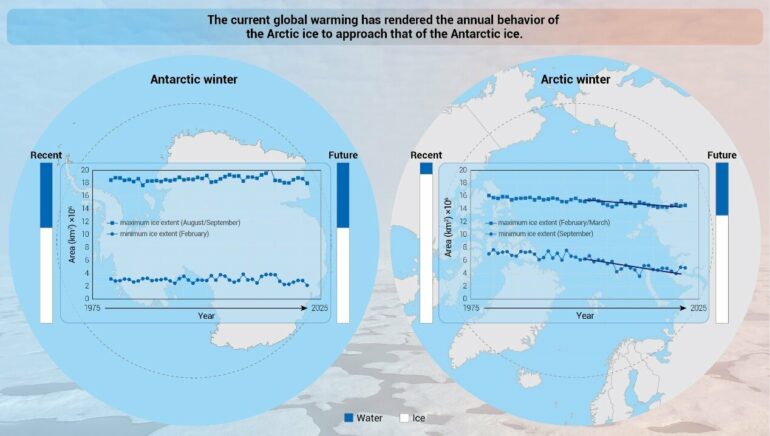Researchers have used data from previous publications aiming to answer the question of why the Arctic sea ice is responding much more quickly and obviously to climate change than the Antarctic sea ice, which has stayed relatively stable according to the long-term studies monitoring the Antarctic region’s sea ice patterns. Their results were published in the journal Ocean-Land-Atmosphere Research.
“The differences in responses are explained in terms of geographic, climatic and meteorological differences between the two regions. Arctic sea ice is located in the polar area and encircled by land, while sea ice in the Antarctic is located far from the polar area outside the Antarctic circle,” said Mohammed Shokr, first author of the paper.
The Antarctic sea ice is still being impacted in the form of calving (formation of icebergs by splitting of glaciers) and the melting of ice shelves, just not as quickly as it appears the Arctic sea ice is melting and thinning in an annual cycle. Naturally, this leads to more discussion surrounding the relevant melting in the Arctic, where its impacts are more immediately noticeable due to the population density in the Northern Hemisphere.
“It is expected that Arctic sea ice will mimic the seasonal behavior of the Antarctic sea ice, namely forming in winter and almost completely vanishing in summer,” said Yufang Ye, author and researcher at Sun Yat-sen University.
The seasonal melting of Arctic sea ice and Antarctic ice shelves can vary with atmospheric and oceanic conditions, both of which can lead to less desirable effects on transportation, economies, and the weather. Both regions have melting incidences, but they’re occurring for different reasons. This would suggest each problem has the potential for its own answer, and that the two should not necessarily be looked at through the same lens.
The authors suggest an alternate question to the popularly posed inquiry of why the Arctic sea ice is more responsive to climate change than Antarctic sea ice: how did the Arctic ice patterns come to mimic the Antarctic’s through the impact of global warming?
To gain a comprehensive understanding of how sea ice behaves in response to climate change in both the Arctic and Antarctic regions, continuous monitoring is essential. Given the unique quirks and peculiarities of each region, it is crucial to investigate them separately to better answer to the question of how global warming has triggered the shift in Arctic sea ice patterns. Addressing these region-specific questions may lead to further research and insights on the impacts of climate change on sea ice.
More information:
Mohammed Shokr et al, Why Does Arctic Sea Ice Respond More Evidently than Antarctic Sea Ice to Climate Change?, Ocean-Land-Atmosphere Research (2023). DOI: 10.34133/olar.0006
Provided by
Ocean-Land-Atmosphere Research (OLAR)
Citation:
Similar but different: Antarctic and Arctic sea ice and their responses to climate change (2023, May 5)



